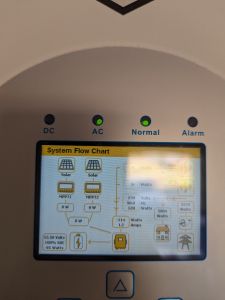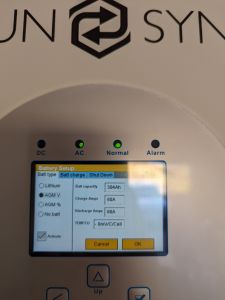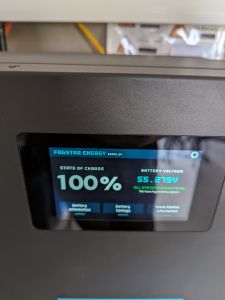Hi all,
Quite a tricky question with an odd setup.
I have an existing solar setup 9KW of solar panels on the roof with a 8KW Solis inverter.
I also have an old powervault P3 (4kw) ac coupled battery, this is being replace with a new Sunsync 5kw eco inverter and a Fogstar 15.5kwh battery, the old powervault has quite a nice interface where you can edit what the battery is doing, the modes available are:
Normal - auto if power is going out to the grid use it to charge the battery if a big load in the house needs power then discharge the battery
Force discharge - will dump as much power as it can until battery is flat
Force charge - will charge as fast as it can, will use the grid if needed
disable - battery will do nothing
dormant - low power, reduce the load needed to run the battery from 40w to 10w
only charge - will soak up power going back to the grid but will not discharge if the house needs it for a big load
only discharge - will not charge the battery even if power is flowing back to the grid, but will provide power to run the house.
What setting do I need to use on the sunsync inverter to get the normal mode, charge if exporting power but run the house if a big appliance like a dishwasher / oven are turned on?
Also looking to integrate the sunsynk inverter in to home assistance so I can automatically charge the battery from the grid when the cost of grid power drops below a threshold (octopus agile), anyone have any knowledge of that?
Hi @djbuzz-07 - interesting set of questions...
The PowerVault battery technology is well known to me, but I don't think that's relevant to your enquiry!
Please note, however, that you need to take care on how you decommission it.
The battery chemistry is LiMNC, rather than the more common LiFePO4 we use within homes.
LiMNC is the type you see catching fire on YouTube videos. It's an exothermic reaction, and difficult to stop. 😲
Why did you choose that PowerVault battery in the first place?
What's changed such that you no longer wish to use it?
Posted by: @djbuzz-07What setting do I need to use on the sunsync inverter to get the normal mode, charge if exporting power but run the house if a big appliance like a dishwasher / oven are turned on?
That can't be done just by configuring the inverter.
You'd need to have sensors on the circuit from your Distribution Board to detect when the current went above a particular level.
Otherwise, how could any electronics 'know' that an appliance with heavy power demands was 'active'?
Anyway, as it's a SunSync inverter, why would you want to have it exporting anything to the grid?
One of the main features of SunSync is that their equipment has ENA approval for Zero export to grid.
That's why you'll get a quick response when you request G99 approval from your DNO.
Save energy... recycle electrons!
I've had the P3 for around 4 years so there were a lot fewer options when I got that, I've moved house and moved the PV3 to the new home but it's old, not large enough (4kwh but in reality you get around 3.3kWh from a full charge) and it really inefficient by todays standards a total round trip efficiency of 62.8% on a good day.
The new inverter will have a CT coil, the PV3 had two ct coils one for the grid and one for solar output, the grid was the only one that controlled the battery the solar one was just for graphs and single dashboard
Already have G99 approval from the DNO, I want to use power from solar to charge the battery but on sunny days I make over 60kwh and send back the power and get paid 15p per kWh
My main question was around the timer setting, in the manual it seems a bit vague, I want a mode that is almost auto, if power is flowing back to the grid (exporting) and the battery is not full use this power to charge, but if if turn on the oven, washing machine and then use more that I'm making from solar, I want the battery to kick in a supply the extra and not the grid.
The installer is removing the old battery and is recycling that according to locals rules and regs.
Posted by: @djbuzz-07I want a mode that is almost auto, if power is flowing back to the grid (exporting) and the battery is not full use this power to charge, but if if turn on the oven, washing machine and then use more that I'm making from solar, I want the battery to kick in a supply the extra and not the grid.
I think that question should be relocated in a Topic about SunSync inverters. It needs to be found by others with direct experience of running Sunsync kit.
Posted by: @djbuzz-07[PowerVault] inefficient by todays standards a total round trip efficiency of 62.8% on a good day.
I agree. I had an 8kWh PowerVault battery for a 2-year trial.
I added additional monitoring which revealed underlying flaws in the firmware.
But that firmware mainly resides within the inverter, which PowerVault themselves bought in from a manufacturer in the Far East.
The efficiency of the unit on trial was around 60%, which correlates with your findings.
Here's a system diagram so that others can see the positioning of two current-sensors you refer to.
The PowerVault Trial gave me a lot of information on how not to implement domestic battery storage, and also led to research into the effect on the grid of exporting from a single-phase source.
I realise that you want to reap the financial rewards from exporting the maximum 3.68kW which you will be permitted to do by your DNO. However, the losses created at the local substation due to phase-imbalance are significant.
It was seeing those losses which took me in the direction of using batteries in off-grid mode, with no possibility of export.
And that's where the strategies using Fogstar and Seplos DIY installation kits makes it a viable route for others to pursue.
The graph above is from one 3-phase 440v feeder on a local substation, 17th June 2024.
The current drawn on each phase is averaged over 10-minute intervals throughout the day.
The shaded area indicates the amount of sunlight available rather than the hours of darkness.
That morning there was only hazy sunshine until 10am.
Houses supplied on Phase L1 have higher amount of rooftop solar panels with export capability.
They require less current from the grid once they are in full sunshine.
The losses incurred by the transformer are in direct relationship to the current flowing in the Neutral.
If the loads were balanced across the phases, then the Neutral wouldn't carry any current.
Save energy... recycle electrons!
Been quite a while since any update - but that's how long it's has taken to get to the root of the issue.
Fogstar has owned up and finally acknowledged that it is the battery BMS that is stopping the inverter from charging to 100%.
Received a beta firmware update for the battery unit. (V1.0.0.0 > V1.0.0.3)
So far so good, seems stable and the charging issue is tackled.
It is only specific to a Sunsynk x Fogstar (PACE BMS) install.
Overall, the 15.5kwh is a wonderful addition to my home.
The money being saved is there for all to see.
@ggw great to hear your having positive progress.
I have my battery in few months now. Very pleased with it. The issue I have is when battery reaches around ~14% it charges its self . Not sure if it's the battery or the inverter causing the issue.
Have Solis inverter
Any one else have this issue?
Interesting, @adrianmc
Do you mean that the battery gets re-charged from the grid when its State of Charge (SoC) is reported as ~14% ?
It's unlikely that there is a command to invoke such action being issued by the battery unit.
All it will be doing is reporting its status to the inverter, probably using a CANbus data connection.
Without knowing a lot about your installation or the Solis inverter, I'll suggest that the most likely cause is a configuration setting in the inverter.
There's probably a parameter to prevent damage to the battery if it were to be discharged to too low a voltage.
If you want to receive a more accurate diagnosis, then you'll need to describe the symptoms better.
I'm beginning to sound like a GP !
Tell us things like:
- model of Solis inverter
- whether you have any solar panels connected
- where you reading the statistic of the battery being at 14% capacity
- what is the actual battery voltage (try to measure this when there's little current flowing)
And you can post a photo of your set-up here too, which might give us a few more clues.
Save energy... recycle electrons!
Hi thanks for the detailed reply.
Have tried to answer your questions below.
- model of Solis inverter--------Solis RHI 3.6K 48ES
- whether you have any solar panels connected-------Yes has solar connected
- where you reading the statistic of the battery being at 14% capacity------From the battery it's self on the front pantel
- what is the actual battery voltage (try to measure this when there's little current flowing)--------Dont know at the moment at moment does not get that low.
Do you mean that the battery gets re-charged from the grid when its State of Charge (SoC) is reported as ~14% ?-------------YES pulls power from the grid
There's probably a parameter to prevent damage to the battery if it were to be discharged to too low a voltage.------ Yes have looked into this and even spoken to solis.
And you can post a photo of your set-up here too, which might give us a few more clues.-----Here short video
Thanks for you help, it's just annoying on the rare occasion at the moment being summer time if it does get that low will pull from the grid.
I have also seen when the battery drops below 14% then the battery grid charged to 30% battery voltage was at 51.7v this is the voltage from the inverter, setting did need seem to make a difference, sunsynk inverters have odd setting and it's hard to work out what ones overrule others?
I have battery setting at:
Shutdown 5%
Restart 7%
Lowbatt 11%
Very odd?
So I'm not the only one who is having this issue. Good to know and your using different inverter.
Can the battery force charge its self
Sunsynk
Are you using lithium/ CAN protocol?
If so, mine always starts grid charge @10%
It is a setting on the inverter.
Cannot discharge below 10 in lithium mode either.
All of this is inverter, not battery controlled.
- 26 Forums
- 2,356 Topics
- 53.4 K Posts
- 230 Online
- 6,017 Members
Join Us!
Worth Watching
Latest Posts
-
RE: Octopus Cosy Heat Pump Owners & Discussion Thread
@kevh with the Cosy 6 I know it definitely goes to arou...
By HarrisonC , 11 hours ago
-
RE: Setback savings - fact or fiction?
@cathoderay yes I am familiar with SQL. Interesting num...
By RobS , 12 hours ago
-

Parsnip, Bacon & Coconut Milk Soup
First let me say, I am only a cook because I am human a...
By Toodles , 12 hours ago
-

RE: Controlling Daikin Altherma via P1P2 and Home Assistant
@weoleyric Oh Dear, I don’t think I am going to be of m...
By Toodles , 13 hours ago
-
RE: Electricity price predictions
Ben Watts posted on LinkedIn that he had updated this w...
By Judith , 18 hours ago
-

RE: The good, the bad and the not that great – my heat pump installation
Small update, Emailed and Spoke to Midea UK and they ...
By Burtis , 18 hours ago
-
RE: Solis S6-EH1P8K-L-PLUS – Why I Chose It and What I’ve Learned So Far
@bash Octopus does charge for the admin. The process al...
By Batpred , 18 hours ago
-
RE: External pipework insulation
@transparent HI all The products you mention are ver...
By David Smith , 18 hours ago
-
RE: New Fogstar 15.5kWh upright solution
Issues still under investigation by Solis... Fogstar ...
By Batpred , 19 hours ago
-
RE: Who's your electricity provider and what's your tariff?
I agree, the consumer is not being properly represented...
By Batpred , 19 hours ago
-
RE: Advice on internal circulation pump noise
Thanks @mikefl - I'll maybe have a look at the lock-shi...
By jtg , 1 day ago
-

RE: Heat Pump Heats the House… But It’s Not Cosy. Emitter Changes or System Tweak?
@toodles interesting suggestion, thanks. I will try to...
By GrahamF , 2 days ago
-
RE: Mitsubishi Ecodan Auto Adaption trial to stop cycling.
The interval you talk of, i think, will be 60min for an...
By F1p , 2 days ago
-
Agree with @majordennisbloodnok on the setbacks. We hav...
By ChandyKris , 2 days ago
-

RE: Speedcomfort radiator fans
@deltona the way the links were added broke the page. A...
By Mars , 2 days ago
-

RE: Refrigerant R32, is it now banned in the EU from 1st Jan 2027 for monobloc ASHPs?
This has been delayed from what I believe to be this ye...
By dgclimatecontrol , 3 days ago
-
RE: Are We Sleepwalking Into Another Race to the Bottom?
this is why I provided current flow temperatures in the...
By ksim , 3 days ago
-

RE: Why Millions of UK Homes Struggle With Heat Pumps
There's many homes that would be quite a disruption for...
By dgclimatecontrol , 3 days ago
-
RE: Ecodan unable to hit legionella target temp - what's the consensus?
@rhh2348 ...maybe this option is what you want? Alter...
By benson , 3 days ago





















